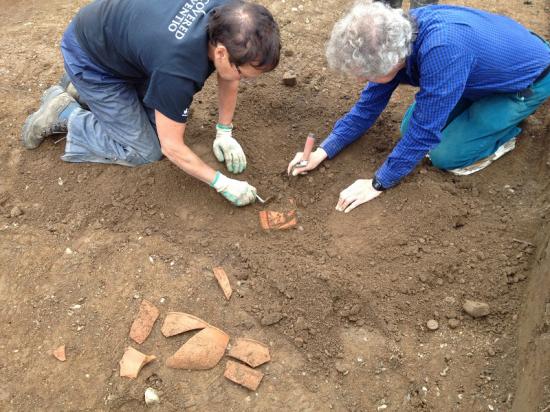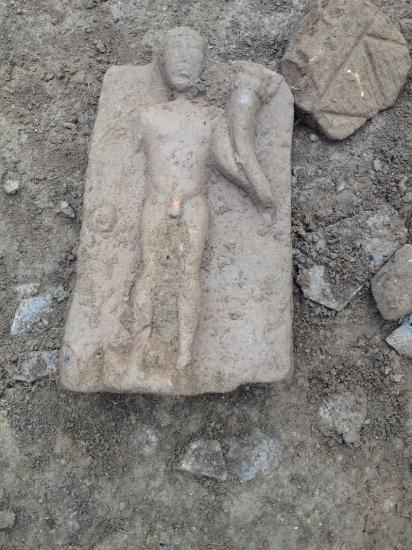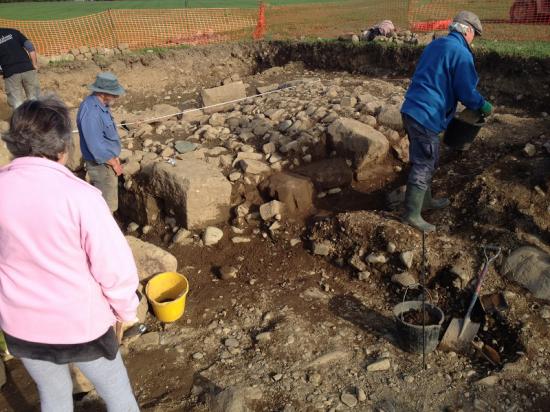Source - http://www.pasthorizonspr.com/index.php/archives/11/2014/discovering-derventio-beyond-the-fort

Volunteer Mick Fairfield with one of the heads at the bridge site. Image: Grampus Heritage
In 2009, terrible flooding hit the county of Cumbria in northwest England, causing extensive damage. As the flood water flowed through Cockermouth, it cut a channel in Broomlands field on the outskirts of the town. When the water level began to subside, local people reported finding fragments of worked stone and Roman pottery. This area had no record of archaeological activity, as remains associated with the Roman settlement at Papcastle were not known to exist on the flood plain or to the south of the river Derwent.
A wealth of features
After being invited to look at the site, Grampus Heritage worked with local volunteers to undertake a magnetometry survey over a 6-week period. This was funded through the Bassenthwaite Reflections HLF Partnership Scheme, and revealed a wealth of archaeological features within the Broomlands field and in other fields to the south and west of Papcastle village. Volunteers carried sensitive instruments across the field in a systematic grid. The magnetometers detect and log changes in the magnetic field above the surface, and the results clearly showed a Roman road, ditched enclosures and buildings on the flood plain.
Having completed the survey, further funding allowed for a four week evaluation excavation at the Broomlands site in summer 2010. Working with North Penines Archaeology and Grampus Heritage, the community excavation revealed that the Roman settlement attached to the fort that modern Papcastle is built in, actually extended south across the river onto the flood plain. The finds from the evaluation spanned the 1st – 4th centuries, and included the important discovery of a Roman watermill with surviving timber lined race. This proved that at least one channel of the Derwent was in the same position as the current river course during the Roman period. Logically, there should have been a crossing point on the river to link the main settlement and fort with the activity and road on the flood plain.
Discovering Derventio Project
The Bassenthwaite Reflections Project finished in 2010. With the support of the local community and the survey showing that there was the potential to do a lot of research in the area, Grampus Heritage received an HLF grant to undertake a 3 year programme of survey and excavation, working with volunteers. The Discovering Derventio Project (investigating human occupation in the Derwent valley) started in 2012 and will run through until the end of 2015. A key element of the ongoing project is an education and outreach programme which is run by the Senhouse Roman Museum. The yearly programme includes autumn/winter geophysical survey, spring evaluation at a site chosen from the results of the geophysical survey and summer/autumn open area excavation. Throughout the year day trips to other sites aids volunteer understanding of Roman Papcastle in the greater Roman landscape, and specialist workshops improve skills and knowledge. Wardell Armstrong Archaeology were appointed as the main contractors during the excavation phases of the project. The expertise of their archaeologists and the friendly and patient way in which they have assisted and trained the volunteers has been invaluable.

Volunteers Ann Asquith and Mick Fairfield lifting Samian bowl. Image: Grampus Heritage
Excavation work
The first 2011 evaluation, which was the developmental phase of the HLF bid, targeted an area across the river to the north of the Broomlands field. The geophysical survey of this area showed evidence of a large building complex with a great deal of magnetic disturbance. The evaluation established that the base of the walls of the building survived and an oven was also excavated with associated cooking pots from the late 1st century. One is now reconstructed and on display in Cockermouth town hall.
In 2012, it was decided to go back to the building and do an open area excavation in order to increase understanding. This revealed that the main structure was a large courtyard building measuring around 30m x 30m, and interpreted as a ‘mansio’, a kind of official inn to host visitors to the settlement. Surprisingly, there were 2 bathhouses associated with this large building but it wasn’t until all the finds and plans had been analysed during post excavation that up to 8 phases of modification and re-use were identified in these buildings. Highlights of this excavation included a well preserved hypocaust with 3 intact Roman stone arches, a candelabrum (Roman lamp stand), a skeleton (the body in the bath house!) and a circular Laconium (steam room).
Following another block of geophysical survey in winter 2012/13, the 2013 evaluation focussed on an open area excavation in the area of the eastern settlement. The geophysics showed the road heading east towards Carlisle and some possible buildings and strip plots alongside. The main excavation in summer 2013 uncovered a Roman strip house fronting onto the road coming into the settlement from the east. This was an important addition to the overall knowledge. One of the key finds was a small figurine of Venus (minus head and feet).

Project volunteers. Image: Grampus Heritage
Recent work
The 2014 season saw further survey to the west side of Papcastle alongside the known route of the Roman road to Maryport. The results showed a track leading to a D shaped enclosure, and it was decided to target this for evaluation. The ditches of the enclosure and a few pieces of pottery were found, showing there had been some Roman activity in the 3rd Century in this area.
It was thought fitting to finish in the Broomlands field where the project first started, and it proved to be an exciting dig, though interpretation of the features was sometimes tricky. There were no solid buildings or walls in the main excavation area but many burnt deposits, ditches, pits and postholes. The site appears to be ritual in nature, with an abundance of decoratively carved stone, altar fragments and inscriptions recovered. The votive artefacts include a copper alloy small axe, deer and boar as well as two small oil lamps. Perhaps the star find is the relief carving of a genius loci, the spirit of the place, symbolising fertility. The deity holds the cornucopia in his left arm with the outstretched right hand probably pouring a libation (liquid offering) from a patera (libation bowl) onto an altar. The carving is quite Celtic in appearance and unusual in that he is naked. It is a fantastic link to the past and a real credit to the volunteers whose hard work and commitment brought such an iconic piece of history to light.
The excavation team also hosted a group under the “Engaging Volunteers in European Heritage Discovery” project which is funded by the EU Culture 2007 programme. The group were made up of people from Germany Iceland, Romania, Slovakia and Turkey and they joined the volunteers for a week on site.

The Genius Loci just after he had been lifted from the ground. Image: Grampus Heritage
Remains of a bridge
It was also exciting to find the remains of a bridge; a key component in recreating and understanding the historic landscape. Associated with the abutment, two fragments of inscription (probably funerary though they have not yet been assessed) were unearthed. Also discovered at the bridge were two altar fragments, one of which was used as the corner of the foundation, two carved heads from statues and the base of a third statue in the rubble of the pier. The abundance of worked stone reused as rubble in the bridge construction suggests that it may be quite late in the Roman period and perhaps even post-Roman?

Foundations of bridge with altar top in foreground. Image: Grampus Heritage
Towards the end of the excavation, significant rainfall led to the river rising and left the bridge trench something of a challenge to excavate. However, after a few trial runs with pumps and sandbags the water subsided sufficiently in order to cut samples of the two in-situ timbers forming the base of the pier, record the main features and backfill the trench immediately in a relatively dry state. The base timber of the structure does have sapwood and there are high hopes for a good dendro date for the felling of this tree.